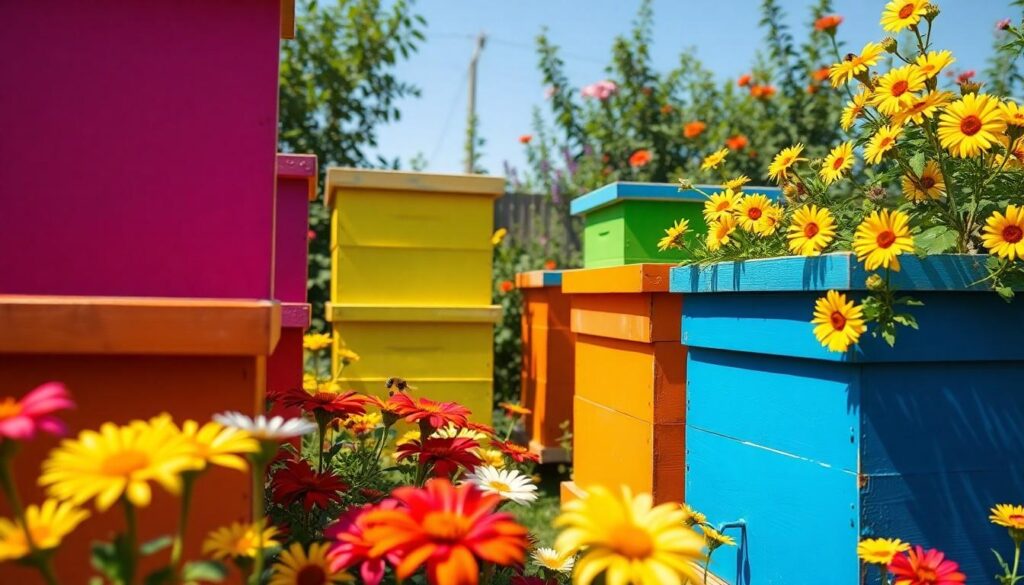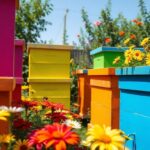Curious about the intriguing area of bee names? We’ve gathered everything you need to know about these remarkable pollinators and their diverse nomenclature. From scientific classifications to common names, understanding what different bees are called helps us appreciate these vital insects even more.
Bees aren’t just “bees” – they’re a diverse group with over 20,000 species worldwide, each with unique names reflecting their appearance, behavior, or habitat. Whether you’re a budding entomologist, a gardener looking to identify your buzzing visitors, or simply bee-curious, knowing these names can deepen your connection to the natural industry around you.
Understanding the Importance of Bee Classification in Our Ecosystem
Bee classification serves as more than just a naming system – it’s a crucial framework that helps us comprehend the intricate roles different bee species play in our network. With over 20,000 bee species worldwide, proper identification and classification allow scientists to track population changes, identify endangered species, and carry out targeted conservation efforts. These taxonomic distinctions reveal how various bee species have evolved specialized relationships with exact plants, creating a complex web of interdependence that sustains our entire food system.
Scientists rely on accurate bee classification to study pollination patterns across different habitats. For example, certain squash varieties depend exclusively on squash bees (Peponapis pruinosa) for pollination, while alfalfa crops require the services of leafcutter bees (Megachile rotundata). Understanding these relationships helps agricultural planners develop effective strategies for crop pollination, especially as honey bee populations face ongoing challenges from disease and habitat loss.
Conservation efforts benefit tremendously from precise bee taxonomy, enabling researchers to identify which species need the most protection. Many native bee populations have declined by 30% or more in recent decades, with some specialist pollinators facing potential extinction. Through detailed classification systems, researchers can pinpoint vulnerable species and create habitat restoration plans that support their exact needs, whether they’re ground-nesting mining bees or cavity-dwelling mason bees.
Climate change research also depends on accurate bee classification to track how different species respond to environmental shifts. Some bee species have already altered their geographic ranges or emergence timing due to warming temperatures. By monitoring these changes across well-classified taxonomic groups, scientists can predict broader network impacts and develop adaptive management strategies for our changing planet.
Educational outreach benefits from accessible bee classification systems that help people connect with these vital insects. When gardeners learn to distinguish between bumble bees, carpenter bees, and honey bees, they develop a deeper appreciation for the diversity visiting their flowers. This knowledge often leads to more pollinator-friendly practices, creating backyard sanctuaries that support local bee populations through thoughtful plant selection and reduced pesticide use.
10 Popular Honey Bee Names and Their Unique Characteristics

The Western Honey Bee (Apis Mellifera)
The Western Honey Bee originated in Africa but has become widespread across Europe, the Middle East, and other parts of the industry through extensive human cultivation. This species has a remarkable history of domestication stretching back thousands of years, with evidence showing they were cultivated during the time of the Egyptian pyramids. Apis mellifera encompasses several important subspecies including Italian, Carniolan, and Russian honey bees, each bringing distinct characteristics to beekeeping operations worldwide.
Italian Honey Bees stand out for their gentle temperament, prolific breeding cycles, exceptional honey production, and distinctive light-colored bodies, making them a top choice among commercial beekeepers. Carniolan Honey Bees have earned their reputation as one of the two most popular bee stocks in the United States due to their impressive honey yields, docile nature, and strong disease resistance. Russian Honey Bees display more aggressive behavior compared to other subspecies, commonly maintain queen cells almost constantly, and show increased vulnerability to pests when cross-contaminated with other varieties.
Physically, Western honey bees feature a stocky body shape with a relatively short and wide abdomen, large head, short antennae, and dense hair covering that serves the dual purpose of trapping pollen and providing protection against predators and parasites.
The Eastern Honey Bee (Apis Cerana)
The Eastern Honey Bee naturally inhabits Asia, thriving in countries such as China, Japan, and India as part of their native network. Similar to its western counterpart, Apis cerana has been domesticated throughout history, though its distribution remains more limited to its original Asian habitats. These bees can be identified by their notably smaller size compared to Apis mellifera, distinctive abdomen stripes, and unique nest-building techniques that set them apart.
Eastern honey bees possess remarkable resistance to certain diseases and parasites, particularly the devastating Varroa mite, giving them a important advantage in their native environments. Their exceptional adaptability to diverse climate conditions makes them particularly valuable in tropical and subtropical regions where other bee species might struggle. Beekeepers throughout Asia prize these bees for their resilience and ability to thrive in challenging conditions while still providing valuable pollination services and honey production.
8 Fascinating Bumblebee Species Names You Should Know

Bumblebees represent some of the most recognizable and ecologically important pollinators in the industry. Here are eight remarkable bumblebee species with distinctive characteristics that make them fascinating to learn about.
The Common Carder Bee (Bombus Pascuorum)
The Common Carder Bee earns its name from its unique habit of collecting and “carding” plant material to construct its nests. Found extensively throughout Europe and Asia, this bumblebee stands as one of the most widespread species in these regions. Its distinctive ginger-brown coloration makes it relatively easy to identify among other bumblebees. Carder bees display remarkable adaptability, thriving in diverse habitats from gardens to woodland edges.
The Buff-tailed Bumblebee (Bombus Terrestris)
Recognized by its distinctive buff-colored tail, the Bombus terrestris holds the title of one of Europe’s most abundant bumblebee species. These bees have established populations across Europe, Asia, and parts of North Africa, demonstrating their impressive adaptability. Commercial growers frequently employ these industrious pollinators for crop pollination due to their efficiency and reliability. Queens of this species are notably large, often among the first bumblebees to emerge in early spring, extending their ecological impact across seasons.
The White-tailed Bumblebee (Bombus Lucorum)
White-tailed Bumblebees closely resemble their buff-tailed cousins but sport a distinctive white tail that serves as their primary identifying feature. These social insects maintain complex colony structures with clear hierarchies and role divisions among queens, workers, and males. Across Europe and Asia, these bees contribute significantly to network health through their tireless pollination activities. Their ability to forage in cooler temperatures makes them especially valuable pollinators in northern climates where other bee species might be less active.
The Tree Bumblebee (Bombus Hypnorum)
Tree Bumblebees display a striking appearance with their black and yellow striped bodies complemented by distinctive white tails. Unlike many ground-nesting species, these innovative bees prefer establishing colonies in tree cavities, bird boxes, and building eaves. UK residents might find it interesting that this species arrived relatively recently, having naturally colonized Britain only since 2001. Their rapid population expansion demonstrates remarkable adaptability to new environments and changing conditions.
The Garden Bumblebee (Bombus Hortorum)
Garden Bumblebees possess exceptionally long tongues that allow them to access nectar from deep, tubular flowers that other bees simply cannot reach. Their specialized feeding apparatus makes them crucial pollinators for certain plant species with complex flower structures. Gardens and meadows throughout Europe and Asia frequently host these beneficial insects as they visit a wide range of flowers. Their distinctive appearance features three yellow bands and a white tail, making them relatively easy to identify for gardeners and nature enthusiasts.
The Heath Bumblebee (Bombus Jonellus)
Heath Bumblebees thrive specifically in heathland and moorland habitats across the UK and other European regions. Unlike some of their relatives, these bees have notably short tongues, which influences their flower preferences and ecological niche. Heather and other low-growing moorland plants receive the majority of visits from these specialized pollinators. Their small size combined with distinct coloration patterns helps naturalists identify them during field surveys of vulnerable habitat types.
The Ruderal Bumblebee (Bombus Ruderarius)
The Ruderal Bumblebee showcases striking red and black coloration that sets it apart from many of its yellow-striped relatives. Population studies indicate this species has become less common in recent decades, raising conservation concerns among entomologists. Even though its declining numbers, these bees demonstrate habitat flexibility, appearing in meadows, gardens, and various transitional landscapes. Their name “ruderal” refers to their historical association with disturbed ground and ruderal plant communities that emerge after human activity.
The Tricolored Bumble Bee (Bombus Ternarius)
North American ecosystems host the distinctive Tricolored Bumble Bee with its unmistakable three-color pattern of black, yellow, and red. Vermont and other northeastern regions of the United States count this species among their most recognizable native pollinators. Their vibrant coloration serves both as a warning to potential predators and as a helpful identification feature for researchers tracking population trends. These bees play crucial roles in pollinating native wildflowers and certain agricultural crops throughout their range.
7 Unusual Solitary Bee Names and Their Remarkable Behaviors

Unlike their social counterparts, solitary bees have fascinating behaviors and unique characteristics that set them apart in the bee industry.
The Blue Orchard Bee (Osmia Lignaria)
Blue Orchard Bees stand out with their stunning metallic blue appearance, making them one of the most visually striking solitary bee species. These remarkable pollinators belong to the Megachilidae family and play a crucial role in orchards and fruit tree pollination. Female Blue Orchard Bees display impressive architectural skills by building their nests in pre-existing cavities like hollow reeds, straws, or wood holes. Their construction method involves using mud to create partitions between individual cells within the nest. Each cell is carefully provisioned with a mixture of pollen and nectar that will feed the developing offspring. Unlike honey bees, these solitary insects work independently to create and maintain their nests without assistance from other bees.
The Leafcutter Bee (Megachile Rotundata)
Leafcutter Bees earn their name from their distinctive habit of cutting perfectly rounded pieces from leaves to construct their elaborate nests. These industrious solitary bees, also known as Alfalfa Leafcutter Bees, belong to the Megachilidae family alongside their blue orchard cousins. Female Leafcutters transport the cut leaf pieces back to their nests using both their powerful mandibles and specialized hairs on the underside of their abdomen. Their preferred nesting sites typically include ground burrows or cavities in dead wood, where each female independently builds her nest, lays eggs, and gathers food for her offspring. Leafcutter Bees handle all parental responsibilities without any cooperation from other bees, demonstrating the self-sufficient nature that defines solitary bee species.
5 Endangered Bee Species Names and Conservation Efforts

1. Rusty Patched Bumble Bee (Bombus affinis)
The Rusty Patched Bumble Bee holds the distinction of being the first bee species listed as endangered in the continental United States. Once abundant across 28 states, this distinctive bee with its namesake rusty patch on its back has experienced population declines exceeding 90% since the late 1990s. Conservation organizations like the Xerces Society lead crucial protection efforts focused on preserving remaining habitats and establishing pollinator corridors. These initiatives aim to connect fragmented populations and provide the diverse flowering plants this species needs for survival.
2. Franklin Bumble Bee (Bombus franklini)
The Franklin Bumble Bee became listed as endangered in 2021, marking it as the first bee species from the American West to receive federal protection under the U.S. Endangered Species List. Even though not being observed since 2006, researchers maintain hope that this elusive species still exists within its native range along the Oregon-California border. Federal funding has been specifically allocated to support research expeditions aimed at rediscovering populations of this critically endangered pollinator. The Franklin’s extremely limited geographic range makes it particularly vulnerable to habitat loss and climate change impacts.
3. Hylaeus anthracinus
Hylaeus anthracinus is one of seven Hawaiian yellow-faced bees added to the endangered species list in 2016, highlighting the unique vulnerability of island ecosystems. These specialized bees inhabit various Hawaiian environments, from coastal areas to wet and dry forests and shrublands. Unlike fuzzy bumblebees, these sleek black bees have distinctive yellow facial markings that give them their common name. Conservation strategies focus on preserving diverse native plant communities that provide consistent sources of pollen and nectar throughout the year, crucial for this bee’s survival.
4. Hylaeus longiceps
Hylaeus longiceps represents another critically endangered Hawaiian yellow-faced bee species facing serious threats to its survival. These distinctive pollinators nest in hollow plant stems and crevices rather than traditional hives or ground burrows. Habitat restoration efforts target the protection of native coastal vegetation where these bees typically make their homes. Conservation programs work to address multiple threats including urban development, invasive plant species that displace native flora, and introduced predators that target these vulnerable insects.
5. Hylaeus assimulans
Hylaeus assimulans faces many challenges as one of Hawaii’s endangered yellow-faced bee species, with populations dramatically declining due to multiple environmental pressures. These specialized pollinators depend on exact native Hawaiian plants for both food and nesting materials. Conservation initiatives focus on addressing the primary causes of decline: habitat loss, natural disasters, land use changes, and competition from invasive species. The U.S. Fish and Wildlife Service works alongside local conservation groups to carry out habitat protection measures and restore native plant communities essential for the survival of this unique bee species.
How Scientists Name Bees: Understanding Bee Taxonomy

The Linnaean System of Classification
Scientists use a exact system called binomial nomenclature to name bee species. This classification method, developed by Carl Linnaeus in 1758, provides a standardized way to identify and categorize every bee on Earth. Each bee receives a two-part scientific name consisting of a genus (always capitalized) and species (never capitalized), both typically written in italics. For example, the Western honey bee carries the scientific name Apis mellifera, where Apis means “bee” in Latin and mellifera means “honey bearing.”
Taxonomic Hierarchy of Bees
The complete taxonomic classification of bees follows a hierarchical structure that places them precisely within the animal kingdom. All bees belong to the kingdom Animalia, phylum Arthropoda, class Insecta, and order Hymenoptera. Moving further down the classification, they fall under the suborder Apocrita, infraorder Aculeata, and superfamily Apoidea. Honey bees specifically belong to the family Apidae, subfamily Apinae, and tribe Apini before reaching the genus Apis and various species designations.
Subspecies Designations
Within major bee species, scientists recognize many subspecies that exhibit distinct traits and geographical distributions. The Western honey bee (Apis mellifera) includes several important subspecies like A. m. carnica (Carniolan honey bee), A. m. ligustica (Italian honey bee), and A. m. scutellata (African honey bee). These subspecies designations help beekeepers and researchers identify exact genetic lineages with unique behavioral traits, disease resistance, and production capabilities.
Historical Naming Corrections
Interestingly, the Western honey bee initially received the name Apis mellifica, meaning “honey producing.” Linnaeus later revised this to Apis mellifera to more accurately reflect the fact that honey bees collect and store nectar rather than producing honey themselves. This correction demonstrates how scientific naming evolves to better represent biological reality and understanding.
Common Names vs. Scientific Names
While scientific nomenclature provides precision and consistency worldwide, common names offer practical everyday references. Scientists generally prefer the term “honey bee” (two words) over “honeybee” (one word) to distinguish it as a type of bee, unlike single-word insects such as butterfly or dragonfly. Common names vary by language and region, making scientific names essential for accurate global communication among researchers studying these important pollinators.
Creative Bee Names for Educational Programs and Beekeeping

Cute and Playful Names
Buzzie tops our list of adorable bee names that instantly create a connection with young learners. Honeydew, Fuzzy Wuzzy, and Cupcake offer sweet options that children can easily remember during educational programs. Sunshine and Sparkle reflect the bright, positive energy bees bring to our network. Bumblebaby serves as a perfect name for newly hatched bees in observation hives. Buttercup, Giggles, and Twinkle add a touch of whimsy that makes learning about pollinators more captivating for elementary students. Marshmallow and Jellybean provide food-themed alternatives that emphasize the connection between bees and our food supply.
Punny Names
Bee-yonce stands out as a clever play on words that older students and adults appreciate in beekeeping programs. Queen Bee-atrice makes an excellent name choice for a hive’s most important resident. Buzz Lightyear and Buzz Aldrin incorporate famous figures while maintaining the bee theme. Sir Hives-a-Lot adds humor to educational presentations about hive structures. Bee-lieve in Yourself and Bee-utiful offer inspirational touches that reinforce positive messaging during conservation talks. The Honey Heist creates an captivating narrative element for interactive learning activities about bee behavior and honey production.
Descriptive Names
Pollen Power perfectly captures the essential role bees play in plant reproduction. Goldenwing highlights the beautiful coloration of many bee species. Honeycomb connects directly to the impressive architectural skills bees demonstrate. Buzzsaw and Buzzzilla provide options that emphasize the distinctive sound bees make during flight. Stingerella offers a creative approach to discussing bee defense mechanisms without creating fear. Pollen Puff and Fuzzyfoot focus attention on the physical characteristics that make bees such efficient pollinators.
Unique and Floral Names
Orchid, Zinnia, and Poppy create direct connections between bees and the flowers they pollinate. Luna and Eclipse offer celestial names that work well for nighttime educational programs. Saffron provides a name that links bees to valuable agricultural products. Freesia and Aster reference beautiful flowers while being distinctive enough to stand out in classroom settings. Tansy, Cedar, and Elder derive from plants that bees frequently visit, reinforcing the plant-pollinator relationship for students. Gossamer elegantly describes the delicate nature of bees’ wings during anatomy lessons.
Educational and Celebratory Names
ABeeC works wonderfully for programs aimed at younger children just beginning to learn about pollinators. Empress and Duchess provide regal alternatives to the common “queen bee” terminology. Jubee-lee creates a festive atmosphere for celebrating special occasions in beekeeping programs. Queenie offers a straightforward yet captivating name for the reproductive center of a hive. Blossom and Flora reinforce the critical relationship between bees and flowering plants in network studies. Bee Mine adds a touch of charm to Valentine’s Day themed educational activities about bee communication and colony relationships.
Beehive Names
Buzzing Palace creates an immediate royal imagery for classroom observation hives. Honeycomb Hideout offers a cozy, approachable name for school beekeeping projects. Nectar Nest emphasizes the important role of food collection in bee communities. Hive Haven provides a simple yet effective name that conveys safety and community. Pollinator Palace elevates the status of bees while highlighting their ecological importance. Golden Grub Garage focuses attention on the nutritional aspects of honey and bee bread production. Bee-treat Retreat offers a clever wordplay that students of all ages can appreciate during educational tours.
How Different Cultures Name and Identify Bees Around the World

Mayan Culture
The Mayans held bees in high regard, naming their bee deity Ah-Muzen-Cab. This god appears in Mayan artwork with distinctive bee wings, symbolizing the important connection between people and pollinators. The Mayans focused their beekeeping efforts on native stingless American bees, harvesting both honey and beeswax as valuable resources. Their deep cultural connection to bees demonstrates how these insects transcended mere economic importance to become embedded in religious practices.
Greek and Roman Mythology
Ancient Greek culture incorporated bees into their religious traditions by calling the priestesses of Demeter “Melissae,” directly translating to “bees.” Artemis also carried the name “Melissa” in certain contexts, showing how bee imagery extended to multiple deities. Romans similarly venerated bees through their goddess Mellonia, who specifically watched over bees and honey production. These classical cultures recognized bees as symbols of industry, community, and divine connection.
Lithuanian and Slavic Mythology
Lithuanian mythology features both a Bee Goddess named Austeja and a Bee God called Babilos, highlighting the dual importance of bees in their cultural framework. Slavic traditions include Zosim, a god specifically associated with beekeeping and honey protection. These northern European cultures developed rich mythological systems around bees, reflecting their crucial role in traditional agriculture and medicine throughout the region.
European Folklore
British and Irish folklore contains many bee-related beliefs, particularly the tradition of “telling the bees” about important family events like births, marriages, and deaths. Families believed failure to inform the hive could result in the bees leaving or dying. Bumblebees buzzing near windows served as natural omens, with folk wisdom suggesting the color of the bee’s tail indicated whether a male or female visitor would soon arrive. These traditions reveal the intimate relationship European households maintained with their local bee populations.
Pedi Culture
South African Pedi culture interprets bee swarms as direct messages from ancestors bringing good fortune to the family. The arrival of a swarm prompts the brewing of mashifa, a traditional unfermented beer made as an offering. This practice integrates bees into ancestral worship systems, demonstrating how pollinators connect the living with spiritual realms in African cultural contexts.
Hindu and Buddhist Cultures
Hindu traditions associate bees with Lord Vishnu and consider honey a sacred substance worthy of religious offerings. Bees feature prominently in religious iconography, often symbolizing spiritual sweetness and divine abundance. The cultural significance extends beyond symbolism to practical applications in traditional medicine and ceremonial foods, showing the multifaceted importance of bees in South Asian cultural systems.
Other Cultural Associations
Bees maintain connections with various other deities including Aphrodite, Brighid, and Rhea across different cultural traditions. Their consistent presence in industry mythologies spans continents and time periods, demonstrating their universal importance to human societies. These widespread associations highlight how bees serve as powerful symbols of fertility, organization, and prosperity in diverse cultural contexts worldwide.
Choosing Perfect Names for Your Backyard Beehives

Personal and Creative Names
Naming your beehives offers a wonderful opportunity to express your personality and creativity. We’ve found that many backyard beekeepers choose names based on personal preferences or exact themes that resonate with them. Consider naming your hives after meaningful places like “Camelot” or “Paradise” to create a special connection to your apiary. These personal touches make your beekeeping journey more enjoyable and help visitors remember your unique setup.
Reflecting Hive Characteristics
Beehive names can effectively showcase the distinctive traits of each colony. For highly productive hives, names like “Honeyland” or “Golden Hive” perfectly capture their industrious nature. Watch your colonies develop over time and let their individual personalities inspire their names. This naming approach creates a practical system that highlights the strengths and qualities of each hive in your collection.
Thematic Names
Using consistent themes for naming multiple hives creates cohesion across your apiary. Literary or historical references provide rich inspiration – names like “Camelot” evoke legendary settings while connecting your beekeeping practice to cultural traditions. Nature-inspired names such as “Blossom” or “Meadow” beautifully link your hives to their surrounding environment. For beekeepers with a playful side, whimsical options like “BeeBop” or “Kiss the Hive” add fun elements to your backyard apiary.
Business-Oriented Names
Running a beekeeping business requires names that reflect your brand identity and mission. “Honeyland Apiaries” directly communicates your focus on apiary management while building customer recognition. “The Beeman” conveys expertise and craftsmanship that potential customers will remember. “Hivemind Apiaries” suggests a well-managed, cohesive operation that produces quality honey products. Effective business names serve both as identification tools and powerful marketing assets.
Simple and Descriptive Names
Many experienced beekeepers prefer straightforward naming systems that serve practical purposes. Simple numerical designations like “Hive 1” and “Hive 2” create clear record-keeping systems that track colony development. Location-based names such as “East Hive” and “West Hive” help quickly identify each colony’s position in your yard. These practical naming approaches particularly benefit beekeepers managing multiple hives who need efficient identification systems for daily maintenance.
Conclusion: The Significance of Learning Bee Names for Conservation
Diving into the industry of bee names reveals much more than scientific terminology. It connects us to a rich tapestry of biodiversity essential for our planet’s health and food security.
By understanding bee nomenclature we become better advocates for these vital pollinators whether we’re beekeepers researchers or simply nature enthusiasts. Each name tells a story of adaptation evolution and ecological significance.
As bee populations face unprecedented challenges learning to identify and appreciate different species empowers us to participate in conservation efforts. From the common honey bee to endangered specialists every bee plays a crucial role in our network.
We hope this guide inspires you to look more closely at the bees in your garden and perhaps even name a few of your own. The future of these remarkable creatures depends on our recognition of their diversity and our commitment to protecting it.
Frequently Asked Questions
Why is understanding bee names important?
Understanding bee names is crucial for tracking population changes, identifying endangered species, and implementing conservation efforts. With over 20,000 bee species worldwide, proper classification helps scientists monitor how bees respond to environmental shifts and supports agricultural planning. It also enables people to connect with bee diversity, promoting pollinator-friendly practices in gardening and fostering appreciation for these vital pollinators.
What is the most common honey bee species?
The Western Honey Bee (Apis mellifera) is the most common honey bee species worldwide. It has been domesticated for thousands of years and is the primary species used in commercial beekeeping. This bee is responsible for the majority of honey production globally and provides essential pollination services for numerous crops, making it economically valuable across agriculture and food production industries.
How do bumblebees differ from honey bees?
Bumblebees are larger, rounder, and hairier than honey bees, with distinct fuzzy bodies. They form smaller annual colonies (50-400 bees) compared to honey bees’ perennial colonies (up to 60,000 bees). Bumblebees can fly at lower temperatures and vibrate flowers to release pollen (buzz pollination), making them superior pollinators for certain crops. While they produce small amounts of honey for their own use, they don’t store excess for harvest.
What are solitary bees and why are they important?
Solitary bees are non-colony-forming bees where females build individual nests and care for their own offspring without worker bees. They constitute about 90% of bee species worldwide. Despite their independent lifestyle, solitary bees are incredibly efficient pollinators—often outperforming honey bees for specific crops. Species like the Blue Orchard Bee and Leafcutter Bee are increasingly valued in agriculture for their specialized pollination abilities and adaptability to different environments.
Which bee species are endangered?
Several bee species face extinction, including the Rusty Patched Bumble Bee, which has declined by 87% in the last 20 years, and the possibly extinct Franklin Bumble Bee, not seen since 2006. Three Hawaiian yellow-faced bees (Hylaeus anthracinus, Hylaeus longiceps, and Hylaeus assimulans) received endangered status in 2016. These species face threats from habitat loss, pesticides, climate change, and disease, highlighting the urgent need for conservation efforts.
How do scientists name bee species?
Scientists use the binomial nomenclature system developed by Carl Linnaeus to name bee species. Each bee receives a two-part Latin name: a genus (like Apis) and species (like mellifera). This standardized system places bees within a broader taxonomic hierarchy from kingdom to species, with possible subspecies designations for genetic lineages with unique traits. Unlike variable common names, scientific names ensure precise global communication among researchers.
Can I name my backyard beehive?
Absolutely! Naming your beehive adds a personal touch to beekeeping and helps with identification. Consider names reflecting your personality, meaningful places, or the colony’s unique traits. Theme-based naming (like literary characters or celestial bodies) works well for multiple hives. Business-oriented beekeepers might choose names aligned with their brand. Whether creative or practical, thoughtful naming enhances your connection to your apiary.
What role do bees play in different cultures?
Bees hold significant cultural importance worldwide. The Mayans revered the stingless bee and had a bee deity named Ah-Muzen-Cab. Ancient Greeks and Romans saw bees as symbols of industry and community. European folklore includes the tradition of “telling the bees” about family events. The Pedi culture in South Africa interprets bee swarms as ancestral messages, while Hindu and Buddhist traditions associate bees with divine abundance. Across cultures, bees symbolize fertility, organization, and prosperity.
How can I create a cute or creative name for a bee character?
For bee characters, consider playful options like Buzzie, Honeydew, or Bumble for cute names. Puns work well with names like Bee-yonce or Queen Bee-atrice. Descriptive names such as Pollen Power or Goldenwing highlight bee characteristics. Floral names (Orchid, Poppy) reflect their relationship with flowers. Educational programs might use names like ABeeC or Spelling Bee. These creative names engage learners of all ages and foster deeper connections to bees’ ecological importance.
Why are Eastern Honey Bees valuable to beekeepers?
Eastern Honey Bees (Apis cerana) are prized for their exceptional adaptability to Asian environments and natural resistance to parasites like Varroa mites. They practice unique hygienic behaviors, including coordinated group defense against predators like hornets. These bees can forage in light rain and maintain stable populations in diverse conditions. Though they produce less honey than Western honey bees, their resilience makes them invaluable for sustainable beekeeping, particularly in their native Asian habitats.







